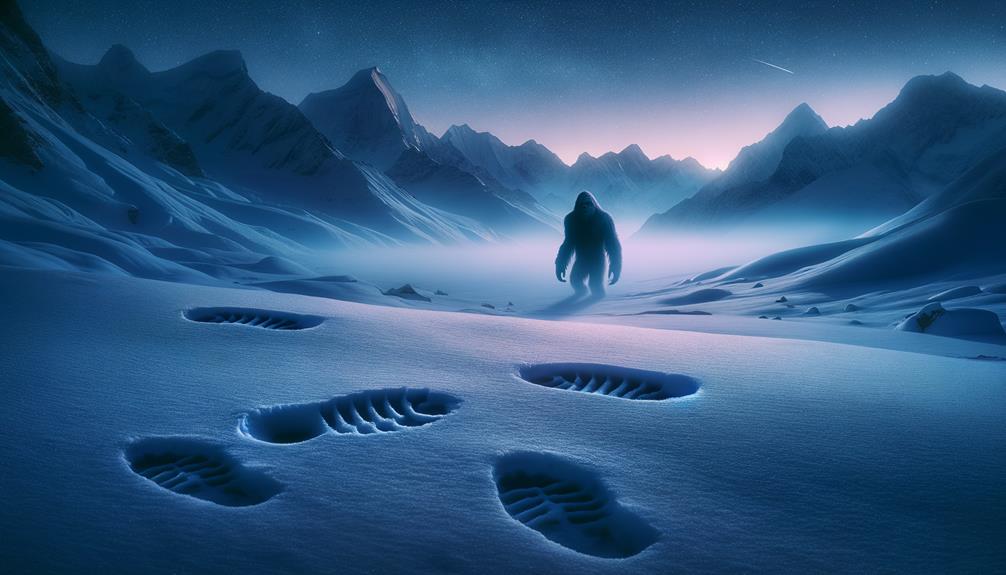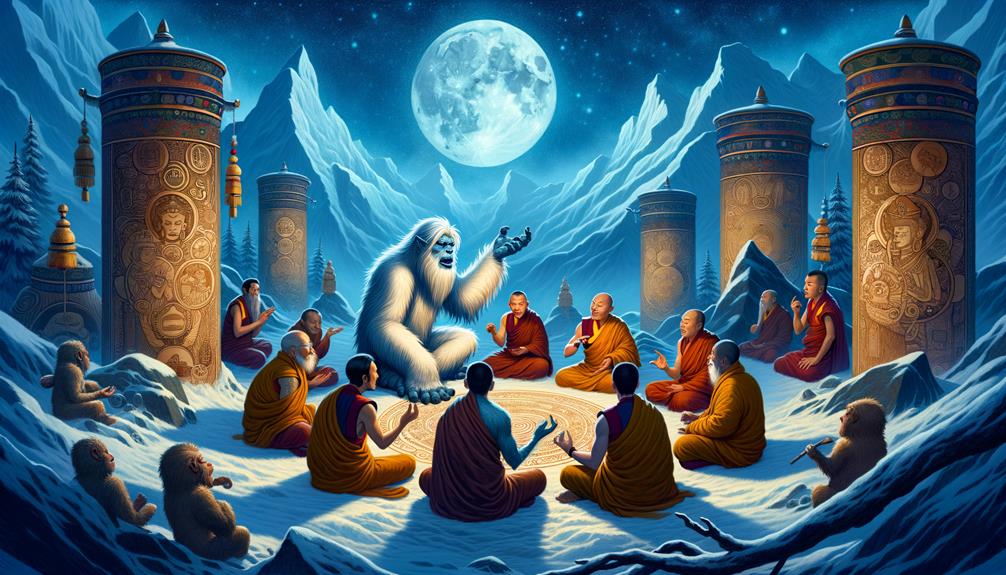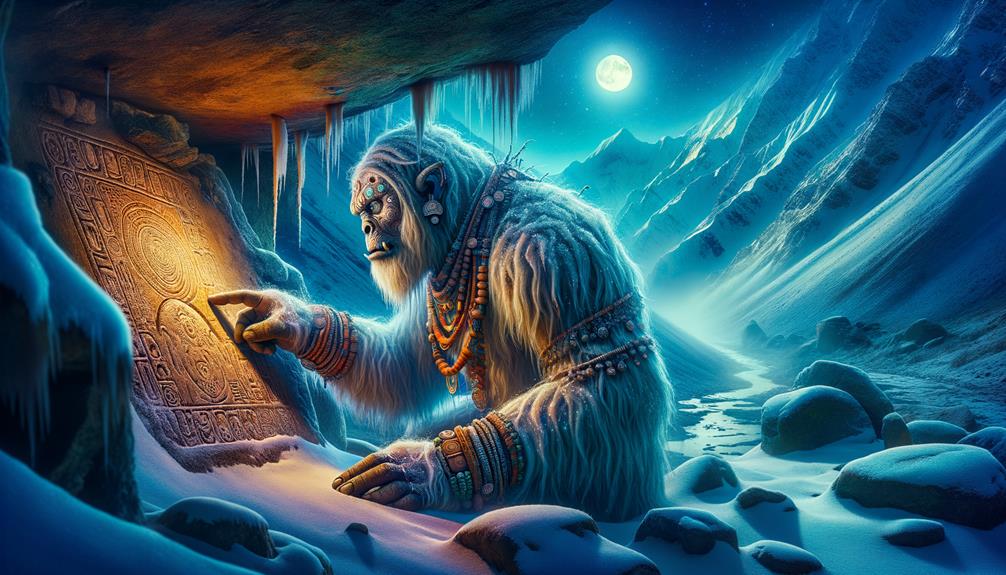You know, some folks might just wave off the study of Yeti culture as nothing more than make-believe or old wives' tales. But in my experience, it's actually a really cool way to look at bigger cultural stories and the beliefs we all share as a society. I've been digging into this fascinating topic and found out that the Yeti, often shown as a scary and hard-to-find creature from the Himalayas, is actually a big part of the cultural life in places like Nepal, Tibet, and Bhutan. Whether it's real or just a story, the Yeti is a strong symbol that mirrors our fears, hopes, and how we see our natural world. But it does make you wonder: why has the Yeti, whose existence is so hotly debated, managed to hold such a strong place in the cultural thoughts of these societies?
Understanding the Yeti Phenomenon

To get a grasp on the yeti phenomenon, it's key to look into its origins in the Himalayas, where it became a part of local folklore as an intimidating figure reminding locals of the dangers of straying too far from home. The legend of the yeti spread through the cultures of Nepal, Tibet, and Bhutan, deeply influencing the mindset of the Himalayan residents. The mystery around the yeti, which holds a commanding presence in their thoughts, can be traced back to the mention of the yeti in their stories and the numerous yeti sightings, which are often brushed off as hallucinations due to high altitude or cases of mistaken identity.
The elusive nature of the yeti added to its intrigue, with locals attributing supernatural abilities to it. This belief was the catalyst for setting up wildlife sanctuaries for its preservation. Items like the yeti scalp, which is respected in a Buddhist shrine, further extended its legendary status.
On the other hand, the existence of the yeti might merely stem from stories of large apes that used to live in the Himalayan region. Scientific examination of such artifacts, including the supposed yeti scalp, has largely discredited their association with unknown creatures, questioning the physical existence of the yeti. This investigation helps to broaden our understanding of the cultural importance and scientific scrutiny related to the yeti.
Yeti Sightings: Facts and Theories

Let's delve into the cultural relevance of the yeti and evaluate the truths and speculations surrounding the claimed sightings of this mysterious creature. This topic has sparked curiosity and lively discussions among locals, tourists, and researchers alike.
- The yeti, often labeled as the 'abominable snowman,' has been a hot-button issue for years. There are numerous stories of individuals stumbling upon large footprints or even the creatures themselves. However, there is no concrete evidence to substantiate these claims, leading to a wide range of theories including misidentification of other animals or plain trickery.
- Many alleged yeti sightings have been discredited over time. For example, so-called yeti remains, like the 'Pangboche Hand,' were identified as human or other recognized animal parts. Tests on supposed yeti hair samples have frequently revealed them to be from bears or dogs.
- The first man to conquer Mount Everest, Sir Edmund Hillary, also participated in a yeti expedition. Despite thorough searches, they found no sign of the mythical creature.
- Over in the Himalayas, the yeti is thought to be more of a myth or legend, deeply rooted in local folklore. Often, it's linked with spiritual practices and tales, with many locals not considering it to be a real creature.
It's important to remember that the yeti's existence is still a topic of debate, with no definitive evidence either proving or disproving its existence. As such, it remains an interesting subject of study and a captivating part of local folklore.
Yeti's Role in Tibetan Mythology

When we delve into Tibetan mythology, we see the yeti as more than just a fabled beast. It's a key symbol of the wild, untamed wilderness, seen as a guardian of the mountains, and has a major role in the spiritual beliefs and customs of the local people. For many who live in the Himalayas, the term 'Yeti' signifies the legend of a guardian spirit, a symbol of the wilderness's untamed essence.
In Tibetan mythology, the yeti isn't just an ordinary creature – it's associated with supernatural powers. There are friendly yeti stories in which the creature helps important people, such as Tenzing Norgay, the well-known mountaineer. But this legendary beast isn't just a character from a tale. It embodies the locals' deep reverence for nature, a belief reflected in their conviction that the creature really exists.
Respected explorers like Charles Howard-Bury have spread the word about the yeti's existence, helping to cement its cultural importance. The yeti's status as a guardian of the mountains has even inspired the creation of wildlife sanctuaries. These insights indicate that the yeti isn't just a mythical beast, but a symbol firmly rooted in the spiritual and cultural life of the Himalayan region.
Yeti Depictions in Popular Culture

Let's move beyond the spiritual and cultural importance of the yeti in its native Himalayan region and consider how it has been portrayed and transformed in popular culture. This ape-like creature, whose existence is cloaked in secrecy, has intrigued people for centuries. With the rise of modern media, this fascination has only intensified, turning the once mythical yeti into a cultural symbol.
- The idea of the yeti inhabiting the slopes of Mount Everest has sparked curiosity among explorers for years. The term 'abominable snowman' was even introduced by journalist Henry Newman.
- The yeti-like creature is a common character in movies and documentaries, often seen as a threatening but misunderstood entity.
- Reality TV shows featuring the yeti tend to revolve around exciting searches for the elusive beast, adding to its appeal.
- The creature's connection to Eastern mythology, especially Tibetan Buddhism, has amplified its significance in popular culture.
These representations of the yeti in popular culture have greatly influenced how we view the creature, solidifying its image as a mighty, supernatural being. The yeti's lasting presence in popular culture symbolizes our intrigue with the unknown and our wish to uncover what remains hidden.
Sociocultural Impact of Yeti Legends

The yeti, a creature deeply woven into the lore of the Himalayan region, fascinates us with its influence on local culture and far-reaching societies alike. The giant ape-like entity has taken root in the hearts of locals, prompting the creation of wildlife sanctuaries. The tales surrounding it offer a stark warning to avoid venturing into dangerous, high-altitude areas.
Over the years, scientists have devoted themselves to solving the yeti mystery. While definitive evidence is still out of reach, various yeti hair samples and the notorious 'scalp of the yeti' have been subject to extensive examination.
The table below summarizes the fascinating and influential impact of yeti legends on society:
| Belief | Scientific Research | Sociocultural Impact |
|---|---|---|
| Yeti as protector | Yeti hair samples & scalp examined | Cautionary tales |
| Sanctuaries established | No concrete evidence yet | High-altitude warnings |
| Yeti believed to protect gods | Attributed to hallucinations or mistaken identity | Enduring worldwide interest |
Whether the yeti is real or just a figment of our collective imagination, its lore continues to bewitch people globally, demonstrating the profound effect of folklore on human behavior and belief systems.
Frequently Asked Questions
What Is the Culture of the Yeti?
I'm delving into the fascinating world of Yeti culture. This creature, often imagined as a guardian of the mountains, holds a special place in Himalayan tales. Even though scientists remain doubtful, a large number of locals maintain a firm belief in the Yeti's existence, attributing it to have mystical abilities.
What Is the Yeti Theory?
So, what's the deal with this yeti theory? Well, it's an idea that suggests there might be a huge, mysterious creature, a primate of some sort, dwelling in the vastness of the Himalayas. Now, there's no solid proof to back this up, but it's a belief deeply ingrained in the local culture and tales. The theory even goes as far as hinting that early humans and these hominids might have shared living spaces. Interesting, isn't it?
What Is the Folklore of Yeti?
Isn't it intriguing how tales and myths can influence our world view? The legend of the Yeti, hailing from the Himalayan region, depicts this mysterious entity as a guardian of the mountains, and a stark reminder to not wander too far from the safety of one's home.
What Does a Yeti Represent?
Well, if you ask me, the yeti is a pretty cool symbol. It's all about the mysteries and might of nature, you know? People see it as a sort of mountain guardian, which really shows how much they value and respect their rugged, but also sacred, surroundings.

